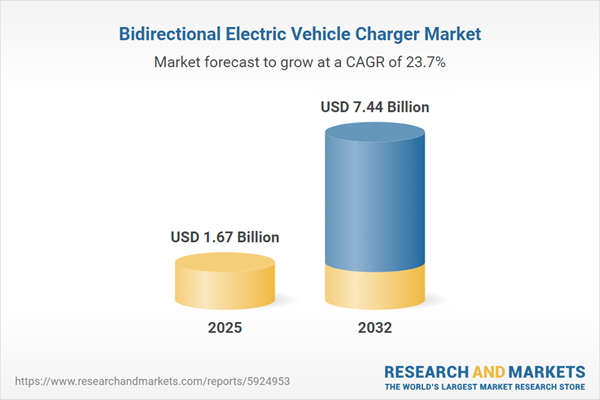Speak directly to the analyst to clarify any post sales queries you may have.
The Bidirectional Electric Vehicle Charger Market is experiencing rapid evolution as businesses, utilities, and technology providers seek adaptive charging solutions to support energy transformation and grid modernization. Senior decision-makers require a clear understanding of drivers, competitive dynamics, and actionable strategies to navigate this emerging landscape.
Market Snapshot: Bidirectional Electric Vehicle Charger Market
The Bidirectional Electric Vehicle Charger Market grew from USD 1.35 billion in 2024 to USD 1.67 billion in 2025, with ongoing expansion expected at a CAGR of 23.72% to reach USD 7.44 billion by 2032. This growth reflects heightened adoption, innovation in grid services, and a shift towards vehicles participating in energy management and local storage. Strong policy support and technology investments are fueling this momentum globally.
Scope & Segmentation
This report delivers an in-depth analysis of market forces, technology trajectories, and strategic imperatives shaping the sector. Coverage spans market size, growth drivers, supply chain shifts, and leading competitors. Key segmentation areas include:
- Vehicle Types: Bus, commercial vehicle, and passenger vehicle applications.
- Connector Standards: AC connectors (Type 1 and Type 2), DC connectors (CCS, CHAdeMO, Tesla).
- Power Output: High power (>22 kW), medium power (7.4–22 kW), and low power (< 7.4 kW) units.
- End Users: Commercial entities, public infrastructure operators, and residential owners.
- Ownership Models: Fleet operator, private ownership, and shared ownership.
- Regional Analysis: Americas (North America and Latin America), Europe, Middle East & Africa—including national markets such as United States, Canada, Brazil, Germany, France, United Kingdom, Italy, and Netherlands—plus Asia-Pacific, covering China, India, Japan, Australia, South Korea, Indonesia, Thailand, and Singapore.
- Key Companies Profiled: ABB Ltd, Schneider Electric SE, Siemens AG, Wallbox NV, Enel X Mobility S.r.l., Nuvve Corporation, EVBox B.V., Delta Electronics, Inc., Engie SA, KEBA AG.
Key Takeaways for Senior Decision-Makers
- Bidirectional charging transforms electric vehicles from energy consumers into dynamic grid assets, supporting energy balancing and decentralized storage.
- Strategic collaboration among automotive manufacturers, utilities, and technology providers accelerates pilot projects, enhances interoperability, and creates new service models.
- Ongoing advancements in power electronics and software optimization are streamlining charging management, enabling adaptive scheduling and advanced energy aggregation.
- Market opportunities vary widely by vehicle type, connector protocol, and ownership structure, requiring tailored product strategies for commercial, residential, and public infrastructure segments.
- Engagement with evolving regulatory and policy frameworks is critical to unlocking favorable participation in demand-response initiatives and incentivized deployment programs.
- Regional market readiness and infrastructure maturity influence the pace of adoption, with North America, Europe, and select Asia-Pacific countries making notable advances.
Tariff Impact and Supply Chain Resilience
Recent US tariffs on imported components are prompting industry-wide adjustments. Companies are mitigating procurement cost increases by localizing production, diversifying suppliers, and forming regional joint ventures. Contract negotiations now emphasize balancing total cost of ownership with innovation, while state-level incentives and utility partnerships are strengthening domestic market foundations.
Methodology & Data Sources
Research findings are based on in-depth interviews with executives from automotive OEMs, utilities, and technology providers, supplemented by a rigorous review of regulatory documents, technical standards, pilot project reports, and strategic filings. Data triangulation and expert advisory panels ensure validation and unbiased insight throughout the analysis.
Why This Report Matters
- Enables senior leaders to benchmark strategies amidst evolving technology and policy conditions.
- Guides product development and market entry with actionable segmentation and regional analysis.
- Supports investment decisions by detailing competitive profiles and supply chain adaptations.
Conclusion
This report provides a strategic foundation for executives seeking to shape the future of bidirectional EV charging. Leverage data-driven insights to capture emerging opportunities and thrive in this evolving market landscape.
Additional Product Information:
- Purchase of this report includes 1 year online access with quarterly updates.
- This report can be updated on request. Please contact our Customer Experience team using the Ask a Question widget on our website.
Table of Contents
3. Executive Summary
4. Market Overview
7. Cumulative Impact of Artificial Intelligence 2025
Companies Mentioned
The companies profiled in this Bidirectional Electric Vehicle Charger market report include:- ABB Ltd
- Schneider Electric SE
- Siemens AG
- Wallbox NV
- Enel X Mobility S.r.l.
- Nuvve Corporation
- EVBox B.V.
- Delta Electronics, Inc.
- Engie SA
- KEBA AG
Table Information
| Report Attribute | Details |
|---|---|
| No. of Pages | 183 |
| Published | November 2025 |
| Forecast Period | 2025 - 2032 |
| Estimated Market Value ( USD | $ 1.67 Billion |
| Forecasted Market Value ( USD | $ 7.44 Billion |
| Compound Annual Growth Rate | 23.7% |
| Regions Covered | Global |
| No. of Companies Mentioned | 11 |









